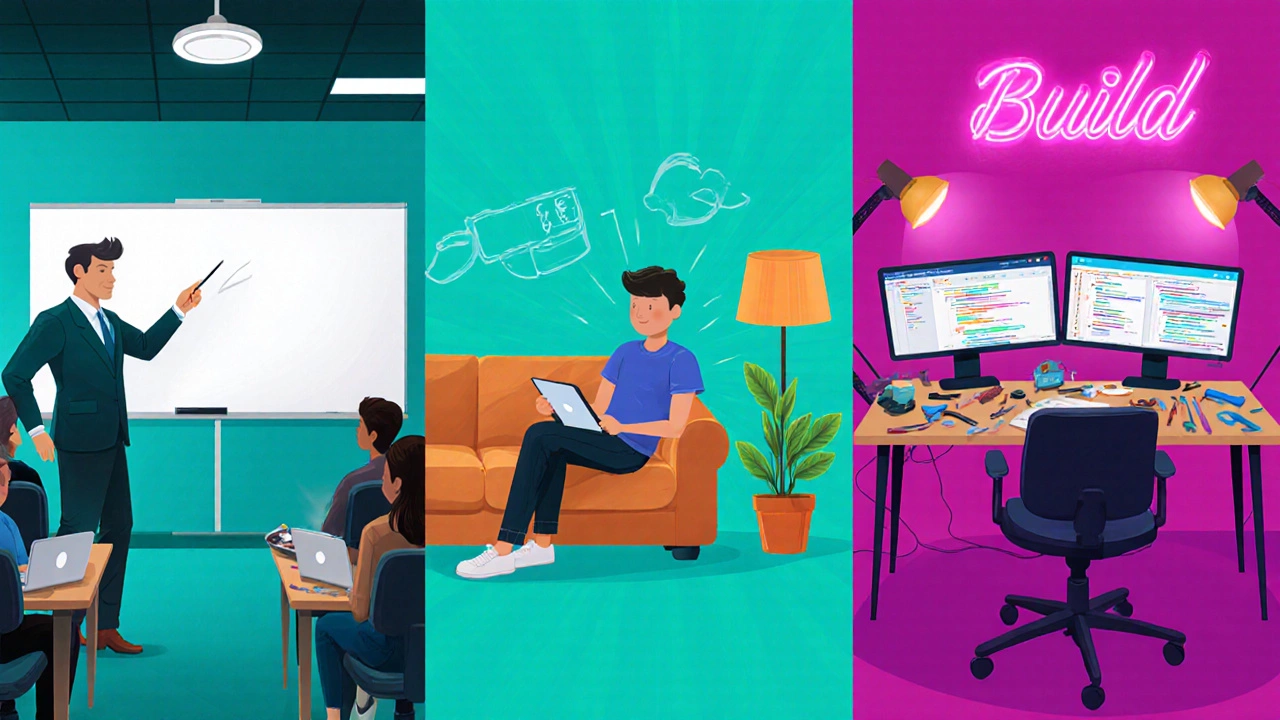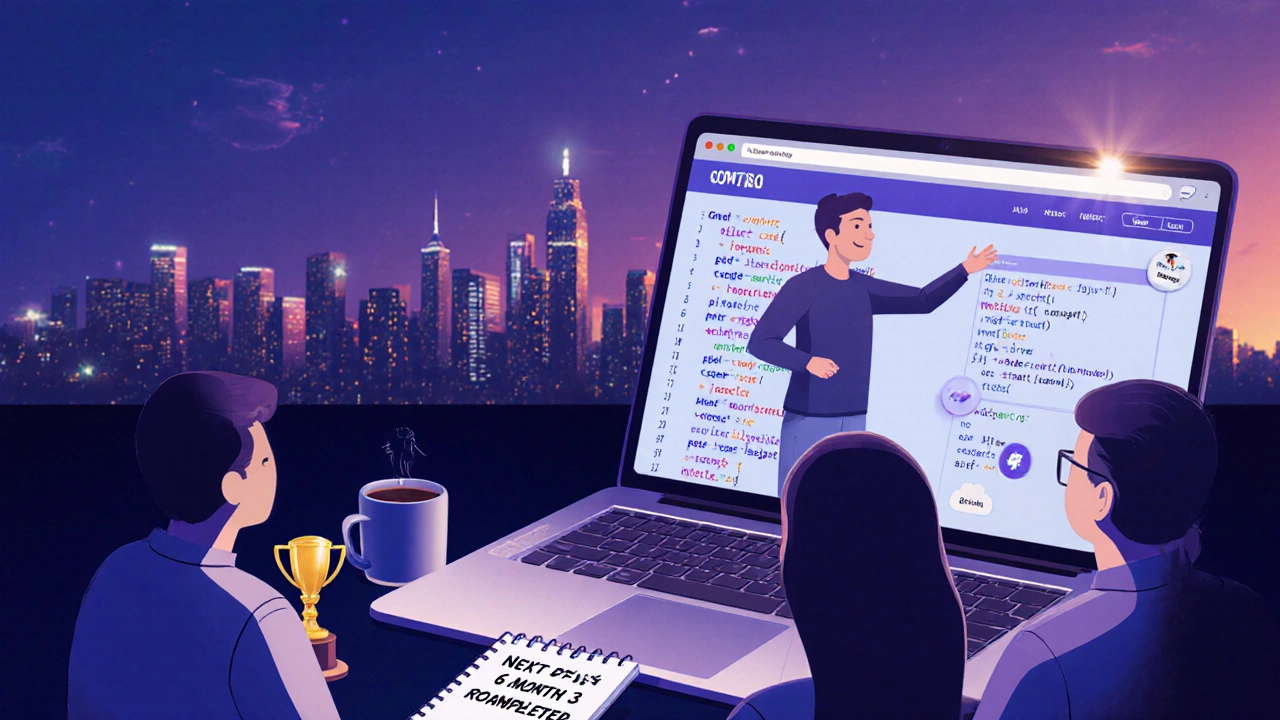3-Month Coding Progress Tracker
Estimated Completion Time
Portfolio Project Tracker
When people ask Coding is the practice of writing instructions that computers follow to perform tasks, they often wonder how quickly they can become competent. The short answer is: yes, you can gain a solid foundation in three months-if you pick the right approach, stay consistent, and focus on real‑world projects.
What a three‑month sprint actually means
Three months is 90 days, or roughly 360 hours if you study 4 hours a day. That’s enough time to cover the basics of at least one programming language, understand core concepts like variables, loops, and functions, and build a few small projects that showcase what you’ve learned. It isn’t enough to become a senior developer, but it can turn a total beginner into someone who can land an entry‑level coding job or freelance gig.
Choosing the right learning path
There are three popular ways to learn quickly:
- Bootcamp is an intensive, instructor‑led program that combines lectures, labs, and mentorship over a short period.
- Self‑paced online course is a collection of video lessons and exercises you can follow on your own schedule.
- Project‑based learning is learning by building real applications from day one.
Each path has pros and cons, but the fastest progress usually comes from a hybrid: a structured curriculum (like a bootcamp) paired with hands‑on projects you build for yourself.
Core skills to master in 90 days
- Learn Python basics or JavaScript fundamentals. Both languages are beginner‑friendly and power many entry‑level jobs.
- Understand version control with Git and host your code on GitHub. Employers expect you to know how to collaborate.
- Grasp basic data structures (arrays, objects, dictionaries) and algorithms (sorting, searching). You don’t need deep math, just the intuition.
- Build at least three portfolio projects: a personal website, a simple web app (e.g., to‑do list), and a data‑handling script (e.g., CSV parser).
- Practice problem‑solving on Stack Overflow and coding challenge sites. This sharpens debugging skills.
These milestones keep you focused and give you tangible evidence of progress.
Weekly schedule template
Below is a sample 12‑week schedule that balances theory, practice, and rest. Feel free to shift days based on personal commitments.
- Monday - 2 hrs video lessons (language basics); 2 hrs coding exercises.
- Tuesday - 3 hrs project work; 1 hr reading documentation.
- Wednesday - 2 hrs algorithm practice; 2 hrs pair‑programming or community Q&A.
- Thursday - 4 hrs deep dive into Git and deployment (e.g., Netlify, Heroku).
- Friday - 2 hrs review & flashcards; 2 hrs mini‑hackathon or code review.
- Saturday - 3 hrs optional workshop or guest lecture; 1 hr rest.
- Sunday - Light reading or podcast; no screen time.
Consistency beats marathon sessions. A 4‑hour daily habit is easier to maintain than a 20‑hour weekend binge.

Cost‑effective resources
If budget matters, here’s a mix of free and low‑cost tools that still deliver quality:
- FreeCodeCamp - interactive lessons and real‑world projects.
- Coursera Specializations - often free to audit, $39/mo for certificates.
- YouTube channels like Traversy Media and Corey Schafer - concise tutorials.
- GitHub Student Developer Pack - free access to cloud IDEs, CI tools, and design assets.
When you have a tight timeline, picking a single language and sticking to one learning platform prevents overwhelm.
Comparison of popular learning routes
| Path | Typical Duration | Cost (USD) | Structure | Ideal For |
|---|---|---|---|---|
| Bootcamp (full‑time) | 12 weeks (40 hrs/week) | 3,000-7,000 | Instructor‑led, daily assignments, career services | Learners who thrive on accountability and can invest cash |
| Self‑paced MOOC | 12 weeks (15-20 hrs/week) | Free-200 | Video lessons, optional quizzes, community forums | Those who need flexibility and have a modest budget |
| Project‑based DIY | 12 weeks (10-15 hrs/week) | 0-100 (tools only) | Follow tutorials, build 3+ projects, seek feedback on GitHub | Creative self‑learners comfortable with trial‑and‑error |
Pick the row that matches your learning style. The key is to stay within the 12‑week window and finish at least three showcase projects.
Common pitfalls and how to avoid them
- Trying to learn everything at once. Focus on one language, one set of tools, and one project type before expanding.
- Skipping practice. Theory without coding is like reading a cookbook without cooking. Code for at least 70% of your study time.
- Neglecting community. Ask questions on Stack Overflow, join Discord dev channels, or find a study buddy. Social accountability speeds up learning.
- Ignoring debugging. Learn to read error messages; they are your best teachers.
- Not documenting progress. Keep a learning journal or a blog. It helps you review and shows future employers your growth.

Real‑world success stories
Jane, a 28‑year‑old marketing coordinator, enrolled in a 12‑week full‑stack bootcamp while working part‑time. She spent 4 hours each weekday on lessons and weekends on project work. By week 10, she shipped a simple e‑commerce site for a local boutique. Six weeks after graduation, she landed a junior developer role at a digital agency.
Mark, a recent college graduate, chose a free self‑paced Python track on Coursera. He paired the lessons with daily challenges on LeetCode. After three months, his GitHub portfolio featured a weather app, a budget tracker, and an API scraper. He secured a remote freelance contract worth $2,000 per month.
These stories show that with the right plan, dedication, and community support, three months is enough to become employable.
Next steps after the 90‑day sprint
When the clock hits 0, don’t stop. Here’s a short roadmap for the next 3‑6 months:
- Deepen your language knowledge: explore advanced topics like asynchronous programming or object‑oriented design.
- Learn a complementary technology: if you started with Python, try JavaScript for front‑end work, or vice‑versa.
- Contribute to open‑source. Pick a small issue on GitHub, submit a pull request, and get feedback from seasoned developers.
- Prepare for technical interviews: study common patterns, practice whiteboard coding, and mock interviews.
- Update your résumé and LinkedIn with the projects you built. Highlight the impact (e.g., “Built a task manager used by 150+ users”).
By layering new skills on top of your 3‑month foundation, you’ll transition from beginner to competent developer within a year.
Final thought
If you keep a realistic schedule, focus on one language, build real projects, and stay engaged with a community, you can learn coding fast in just three months. It’s not magic; it’s disciplined, project‑driven learning.
Can I become a professional developer in three months?
You can gain enough skills to qualify for junior or entry‑level roles, especially if you build a solid portfolio during those three months. Senior positions usually require years of experience, but the foundation you create can launch a career.
Which language should I start with?
Python and JavaScript are the most beginner‑friendly. Python shines for data, automation, and back‑end work, while JavaScript lets you build interactive websites. Choose the one that aligns with the type of projects you enjoy.
Do I need a bootcamp to finish in three months?
Not necessarily. Bootcamps provide structure and mentorship, which can speed up learning, but self‑paced MOOCs combined with disciplined project work can achieve the same result if you stay accountable.
How many hours per day should I study?
Aim for 4-5 hours of focused study each day. Consistency matters more than marathon sessions. Break the time into 1‑hour blocks with short breaks.
What should my portfolio include?
Include a personal website, a front‑end app (like a to‑do list), and a back‑end script (such as a data parser). Provide source code links on GitHub and a brief description of each project’s purpose and tech stack.
